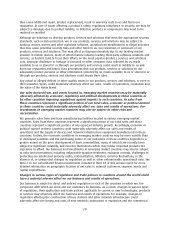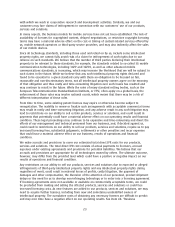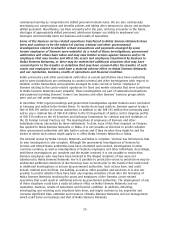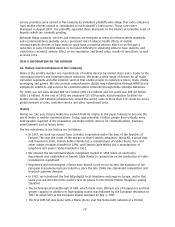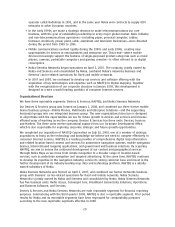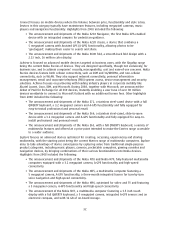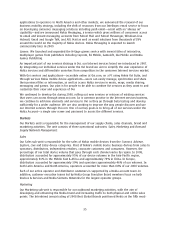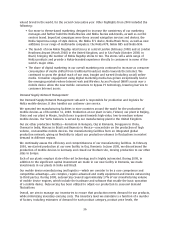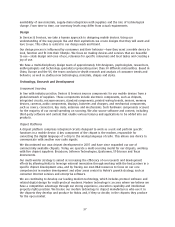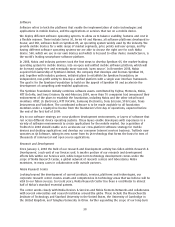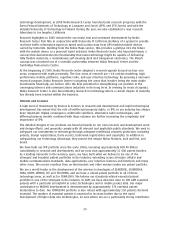Nokia 2008 Annual Report Download - page 30
Download and view the complete annual report
Please find page 30 of the 2008 Nokia annual report below. You can navigate through the pages in the report by either clicking on the pages listed below, or by using the keyword search tool below to find specific information within the annual report.operator called Radiolinja in 1991, and in the same year Nokia won contracts to supply GSM
networks in other European countries.
• In the early 1990s, we made a strategic decision to make telecommunications our core
business, with the goal of establishing leadership in every major global market. Basic industry
and nontelecommunications operations—including paper, personal computer, rubber,
footwear, chemicals, power plant, cable, aluminum and television businesses—were divested
during the period from 1989 to 1996.
• Mobile communications evolved rapidly during the 1990s and early 2000s, creating new
opportunities for devices in entertainment and enterprise use. This trend—where mobile
devices increasingly support the features of singlepurposed product categories such as music
players, cameras, pocketable computers and gaming consoles—is often referred to as digital
convergence.
• Nokia Siemens Networks began operations on April 1, 2007. The company, jointly owned by
Nokia and Siemens and consolidated by Nokia, combined Nokia’s networks business and
Siemens’ carrierrelated operations for fixed and mobile networks.
• In 2007 and 2008, we continued to develop our services and software offering with the
acquisition of key technologies and expertise such as NAVTEQ in digital mapping. Together
with the reorganization of our corporate structure in January 2008, this development is
designed to create a world leading portfolio of consumer Internet services.
Organizational Structure
We have three reportable segments: Devices & Services; NAVTEQ; and Nokia Siemens Networks.
Our Devices & Services group was formed on January 1, 2008, and combined our three former mobile
device business groups—Mobile Phones, Multimedia and Enterprise Solutions—and the supporting
horizontal groups into one integrated business group. The new organizational structure is designed
to align Nokia with the opportunities we see for future growth in devices and services and increase
efficient ways of working across the company. Devices & Services has three units: Devices; Services;
and Markets. The three units receive operational support from our Corporate Development Office,
which is also responsible for exploring corporate strategic and future growth opportunities.
We completed our acquisition of NAVTEQ Corporation on July 10, 2008, one of a number of strategic
acquisitions to bring us the technology and knowledge we believe we need to compete effectively in
consumer Internet services. NAVTEQ is a leading provider of comprehensive digital map information
and related locationbased content and services for automotive navigation systems, mobile navigation
devices, Internetbased mapping applications, and government and business solutions. By acquiring
NAVTEQ, we aim to ensure the continued development of our context and geographical services
through Nokia Maps as we move from simple navigation to a broader range of locationbased
services, such as pedestrian navigation and targeted advertising. At the same time, NAVTEQ continues
to develop its expertise in the navigation industry, service its strong customer base and invest in the
further development of its industryleading map data and technology platform. NAVTEQ is a wholly
owned subsidiary of Nokia.
Nokia Siemens Networks was formed on April 1, 2007, and combined our former Networks business
group with Siemens’ carrierrelated operations for fixed and mobile networks. Nokia Siemens
Networks is jointly owned by Nokia and Siemens and consolidated by Nokia. Nokia Siemens Networks
has five business units: Radio Access; Converged Core; Broadband Connectivity Solutions; Operations
and Business Software; and Services.
Devices & Services and Nokia Siemens Networks are each reportable segments for financial reporting
purposes. Commencing with the third quarter 2008, NAVTEQ is also a reportable segment. Prior period
results for Nokia and its reportable segments have been regrouped for comparability purposes
according to the new reportable segments effective in 2008.
29



